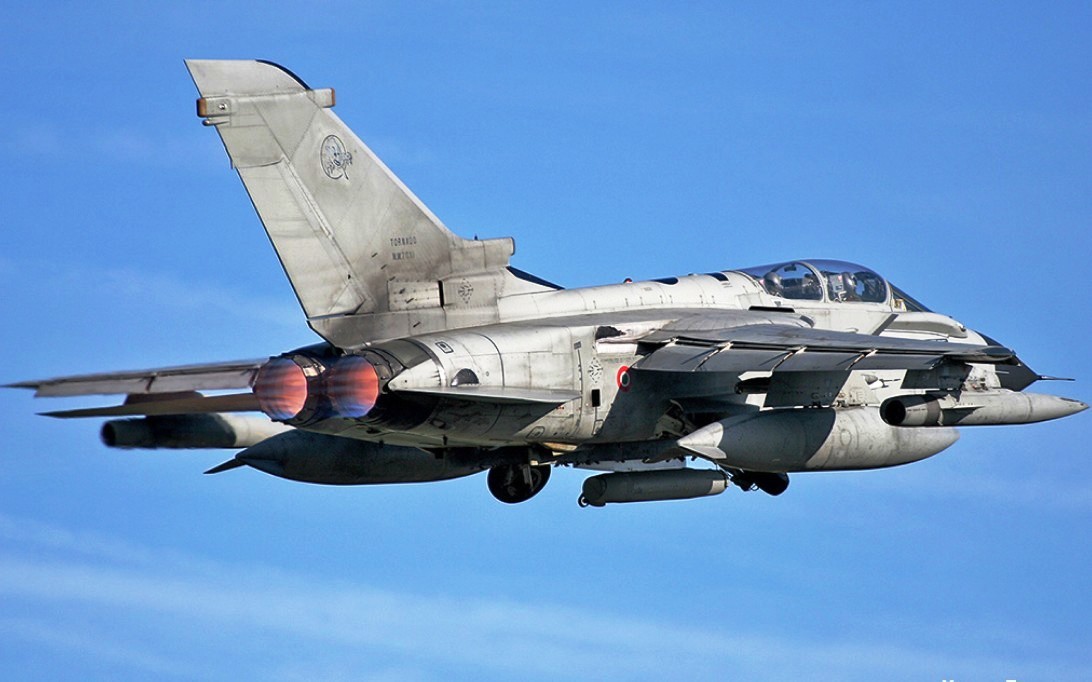 |
| size image : 1092 x 682 |
Tornado IDS (Wallpaper 4)
Tornado IDS fighter aircraft photo wallpaper gallery 4. Tornado IDS fighter airplane pictures and images collection 4.
The Tornado was designed as a low-level supersonic ground attack bomber, capable of taking off and landing in short distances. This requires good high-speed and low-speed flying characteristics. In order to achieve the desired high-speed performance, an aircraft would typically feature a highly swept or delta wing platform. However, these wing designs are very inefficient at low speeds; in order for the aircraft to be operated efficiently at both high and low speeds, variable wing sweep was incorporated into the Tornado design. When the wings are swept back, the Tornado IDS increases its high-speed low-level capability by reducing drag. When sweeping, the wings partially slide into the fuselage, reducing the exposed wing area. The aircraft was designed to be land-based and operate from large airfields that were considered to be vulnerable to aerial attack. Therefore, during the development of the aircraft, short field landing capability was considered essential in order to enable the aircraft to operate from short strips on potentially damaged runways and taxiways. Tornado IDS (Wallpaper 4). Tornado IDS fighter aircraft photo wallpaper gallery 4. Tornado IDS fighter airplane pictures and images collection 4. With the wings swept fully forwards the Tornado IDS generates greater lift because of the increased exposed wing area and the use of full-span flaps and slats. This gives greater lift at lower speeds, reducing the minimum landing speed required and therefore giving shorter landing distances. Thrust reversers are also fitted to help in this respect, the Saab Viggen being the only other fighter aircraft to include this feature. The aircraft was designed to be land-based and operate from large airfields that were considered to be vulnerable to aerial attack. Therefore, during the development of the aircraft, short field landing capability was considered essential in order to enable the aircraft to operate from short strips on potentially damaged runways and taxiways. With the wings swept fully forwards the Tornado IDS generates greater lift because of the increased exposed wing area and the utility of full-span flaps and slats. This gives greater lift at lower speeds, reducing the minimum landing speed required and therefore giving shorter landing distances. Thrust reversers are also fitted to help in this respect, the Saab Viggen being the only other fighter aircraft to include this feature. The reversers contribute to the appearance of soot on the fin surface. Tornado IDS (Wallpaper 4). Tornado IDS fighter aircraft photo wallpaper gallery 4. Tornado IDS fighter airplane pictures and images collection 4.
Tornado IDS (Wallpaper 1)Tornado IDS fighter aircraft photo wallpaper gallery 4. Tornado IDS fighter airplane pictures and images collection 4.
The Tornado was designed as a low-level supersonic ground attack bomber, capable of taking off and landing in short distances. This requires good high-speed and low-speed flying characteristics. In order to achieve the desired high-speed performance, an aircraft would typically feature a highly swept or delta wing platform. However, these wing designs are very inefficient at low speeds; in order for the aircraft to be operated efficiently at both high and low speeds, variable wing sweep was incorporated into the Tornado design. When the wings are swept back, the Tornado IDS increases its high-speed low-level capability by reducing drag. When sweeping, the wings partially slide into the fuselage, reducing the exposed wing area. The aircraft was designed to be land-based and operate from large airfields that were considered to be vulnerable to aerial attack. Therefore, during the development of the aircraft, short field landing capability was considered essential in order to enable the aircraft to operate from short strips on potentially damaged runways and taxiways. Tornado IDS (Wallpaper 4). Tornado IDS fighter aircraft photo wallpaper gallery 4. Tornado IDS fighter airplane pictures and images collection 4. With the wings swept fully forwards the Tornado IDS generates greater lift because of the increased exposed wing area and the use of full-span flaps and slats. This gives greater lift at lower speeds, reducing the minimum landing speed required and therefore giving shorter landing distances. Thrust reversers are also fitted to help in this respect, the Saab Viggen being the only other fighter aircraft to include this feature. The aircraft was designed to be land-based and operate from large airfields that were considered to be vulnerable to aerial attack. Therefore, during the development of the aircraft, short field landing capability was considered essential in order to enable the aircraft to operate from short strips on potentially damaged runways and taxiways. With the wings swept fully forwards the Tornado IDS generates greater lift because of the increased exposed wing area and the utility of full-span flaps and slats. This gives greater lift at lower speeds, reducing the minimum landing speed required and therefore giving shorter landing distances. Thrust reversers are also fitted to help in this respect, the Saab Viggen being the only other fighter aircraft to include this feature. The reversers contribute to the appearance of soot on the fin surface. Tornado IDS (Wallpaper 4). Tornado IDS fighter aircraft photo wallpaper gallery 4. Tornado IDS fighter airplane pictures and images collection 4.
Tornado IDS (Wallpaper 2)
Tornado IDS (Wallpaper 3)
No comments:
Post a Comment